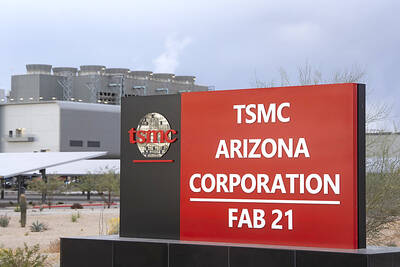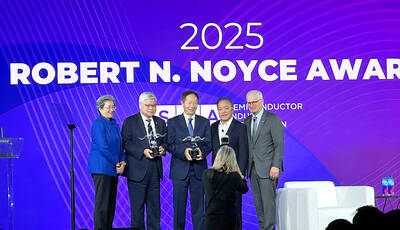Huawei Technologies Co (華為) is close to finishing the construction of a semiconductor research and development (R&D) center in Shanghai, in a move that is likely to advance China’s technological ambitions even as the US tries to halt its rise.
The park, which would be Huawei’s largest research center globally, is to house about 30,000 personnel, statements on the Shanghai government’s Web site says.
The site in Qingpu District covers 1.6 million square meters and has its own road network, a small railway system and elevated bridges which are already in place, the release said.

Photo: Bloomberg
The new facility would pursue breakthroughs in semiconductors for devices, wireless networks and the Internet of Things, said a state media report in January, citing a Shanghai government briefing.
The total investment cost is 10 billion yuan (US$1.4 billion), a statement posted on the Qingpu government’s Web site says.
Huawei has been a target of US sanctions and export controls for years, as Washington and Beijing vie for supremacy in the semiconductor sector.
Last year, the company successfully navigated US restrictions to launch a new 5G phone, which was powered by an advanced made-in-China 7-nanometer chip.
US President Joe Biden’s administration has since initiated further curbs to rein in Huawei’s chip progress, including asking its allies to add new restrictions on China’s semiconductor sector.
It also revoked licenses that allowed Huawei to buy some chips from Qualcomm Inc and Intel Corp in an effort to plug any loopholes in existing conditions.
Industry participants are likely to scrutinize Huawei’s next flagship smartphone, the Mate 70, which is expected later this year, for any signs that Beijing has made further strides in semiconductor development.
Its predecessor, the Mate 60, garnered strong demand from local consumers and helped Huawei gain some market share at the expense of competitors, including Apple Inc.

Shiina Ito has had fewer Chinese customers at her Tokyo jewelry shop since Beijing issued a travel warning in the wake of a diplomatic spat, but she said she was not concerned. A souring of Tokyo-Beijing relations this month, following remarks by Japanese Prime Minister Sanae Takaichi about Taiwan, has fueled concerns about the impact on the ritzy boutiques, noodle joints and hotels where holidaymakers spend their cash. However, businesses in Tokyo largely shrugged off any anxiety. “Since there are fewer Chinese customers, it’s become a bit easier for Japanese shoppers to visit, so our sales haven’t really dropped,” Ito

The number of Taiwanese working in the US rose to a record high of 137,000 last year, driven largely by Taiwan Semiconductor Manufacturing Co’s (TSMC, 台積電) rapid overseas expansion, according to government data released yesterday. A total of 666,000 Taiwanese nationals were employed abroad last year, an increase of 45,000 from 2023 and the highest level since the COVID-19 pandemic, data from the Directorate-General of Budget, Accounting and Statistics (DGBAS) showed. Overseas employment had steadily increased between 2009 and 2019, peaking at 739,000, before plunging to 319,000 in 2021 amid US-China trade tensions, global supply chain shifts, reshoring by Taiwanese companies and

Taiwan Semiconductor Manufacturing Co (TSMC, 台積電) received about NT$147 billion (US$4.71 billion) in subsidies from the US, Japanese, German and Chinese governments over the past two years for its global expansion. Financial data compiled by the world’s largest contract chipmaker showed the company secured NT$4.77 billion in subsidies from the governments in the third quarter, bringing the total for the first three quarters of the year to about NT$71.9 billion. Along with the NT$75.16 billion in financial aid TSMC received last year, the chipmaker obtained NT$147 billion in subsidies in almost two years, the data showed. The subsidies received by its subsidiaries —

Taiwan Semiconductor Manufacturing Co (TSMC) Chairman C.C. Wei (魏哲家) and the company’s former chairman, Mark Liu (劉德音), both received the Robert N. Noyce Award -- the semiconductor industry’s highest honor -- in San Jose, California, on Thursday (local time). Speaking at the award event, Liu, who retired last year, expressed gratitude to his wife, his dissertation advisor at the University of California, Berkeley, his supervisors at AT&T Bell Laboratories -- where he worked on optical fiber communication systems before joining TSMC, TSMC partners, and industry colleagues. Liu said that working alongside TSMC